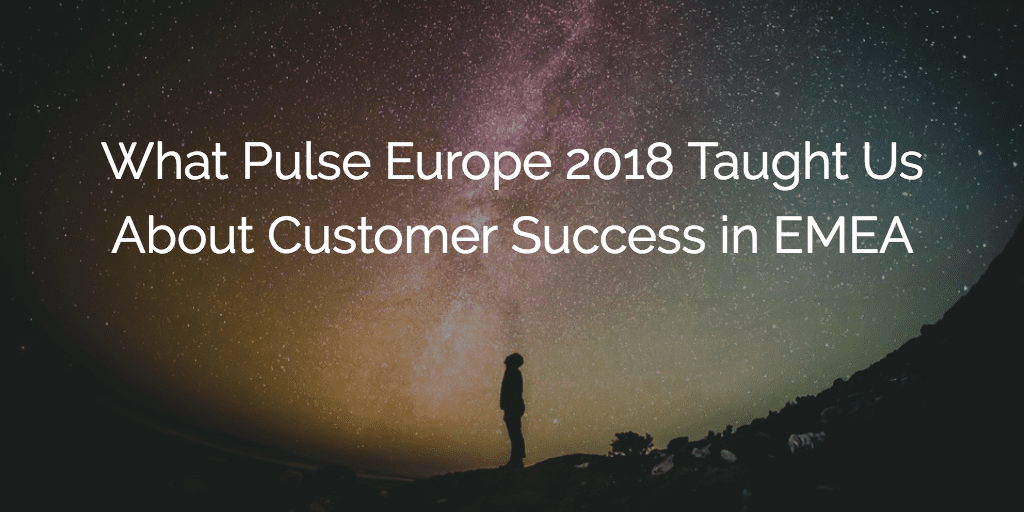Cheers, mate! The fourth annual Pulse Europe has come and gone and we feel pretty full of doughnuts, ice cream, and Customer Success best practices.
Thanks to everyone that joined us for these two days (three days if you attended Pulse Academy Live) of discovery and fun. In case you missed it, or just want to relive the magic, we’ve summed up some memorable moments and takeaways from Pulse Europe 2018. There were so many of them, it was challenging, but here goes!
Like the universe, Customer Success is always expanding

We were beyond stoked to have Professor Brian Cox speak at this year’s event. He shared the many ways we think about the creation of our universe and our place in it. While some of us were reminded how little we actually paid attention in science class, we were also reminded of how far Customer Success has gone on its journey in Europe. Just like the universe, Customer Success is constantly growing and everyone within it is trying to understand their place in the grand scheme of things. Customer Success was created by recurring revenue businesses with the need to retain customers—think of this as the industry’s “big bang.” Since then, Customer Success has grown from a job role to a department, and now requires the entire company’s efforts.
A popular theme at Pulse Europe 2018 was CS > CSM. As our CEO Nick Mehta put it, Customer Success is both a role and a strategy. It takes an entire company to drive the initiatives CS puts in place. Sales teams should sell a product with the right expectations upfront. Product teams should find ways to create meaningful features based on customer interactions. Support and Services teams should be able to access customer data so they can be aware of any patterns of risk. In the end, it’s not just on the shoulders of a Customer Success Manager to ensure a customer doesn’t churn. It requires departments to work together to drive successful outcomes and experiences.
Customer Success is more popular than Pi

We kicked off the last day of Pulse Europe by inviting our resident young Einstein onstage to recite 50 digits of Pi. How many digits of Pi do you know? Only 26% of the population can recite four places after the decimal—and it only goes down from there. Thankfully the outlook is much better for Customer Success; more people in EMEA can tell you what Customer Success is than recite 5 digits of Pi. In an industry survey taken by Pulse Europe attendees, 77% say that CS is a known entity in EMEA business.
Europe and the rest of the EMEA region are closing the gap and quickly advancing the way they think about Customer Success. It’s not just about small SaaS companies anymore. 87% of Pulse attendees say that CS will have a high positive impact on their ability to reach business and customer outcomes. Enterprise players like Microsoft, Autodesk, Oracle, and Cisco are all using CS. This year, we dedicated an entire track to best practices around scaling Customer Success. It featured sessions like, “Breaking Down the Silos of Services and Support,” “Solving the Challenges of Multi-Product Customer Success,” and “Partner Success Management: Customer Success in the Channel.” One of the biggest takeaways from Pulse Europe was that it’just about small recurring revenue businesses anymore. Traditional businesses are also seeing the value in driving long-term customer outcomes, making the discipline more widespread than ever.
Finding Customer Success talent in EMEA is like finding a runway-ready robot

Customer Success talent is a hot commodity, but because Customer Success has only been around for about a decade, it’s hard to find experienced practitioners. If you’ve attended a Pulse event before, you’ll know that there’s no party like a Pulse party. One of the biggest hits at our official after-party this year was the Robot Runway. Teams of four or more were tasked with turning one of their members into a robot using cardboard boxes, foil, lights, and lots of other fun props. Building the robot was only half of the requirement—they then needed to strut their stuff down the runway for our panel of judges. Looks were only half of the score, so it was really up to how much the robot was willing to give it their all on the catwalk. Finding a robot confident enough to shake its wires like there’s no tomorrow is difficult. Almost as hard as it is to find Customer Success practitioners that have deep industry experience. The biggest Customer Success challenge faced by Pulse Europe attendees is finding talent and leadership. However, that doesn’t mean they aren’t out there.
In a nutshell, Customer Success roles call for a unique blend of problem-solving and people skills as well as an understanding of data and operations. This can be a tall order but if you’re interested in pursuing a career in CS, your time is now. If you already work in a customer/prospect-facing role, you have a solid set of skills that will lend well to working in Customer Success. There are an increasing amount of educational opportunities emerging that will give your skills a boost. If you’re attending a future Pulse, we highly recommend checking out Pulse Academy Live. This classroom-style setting helps practitioners uplevel their understanding of beginning and advanced CS tactics. At the end of the day, you also have the opportunity to take a certification course.
So, what’s next?
For Customer Success, there’s nowhere to go but up. The entire world is taking notice and more and more companies are embracing CS. So, it’s only natural that we follow suit to keep our finger on the pulse (we couldn’t help ourselves). Next stop: Sydney, Australia for Pulse APAC. After that, we’ll be back home in San Francisco to hold Pulse 2019. Join us at either one to get in on the amazing learning and network. Once again, thanks to all our Pulse Europe attendees for making this the Pulse to beat!

